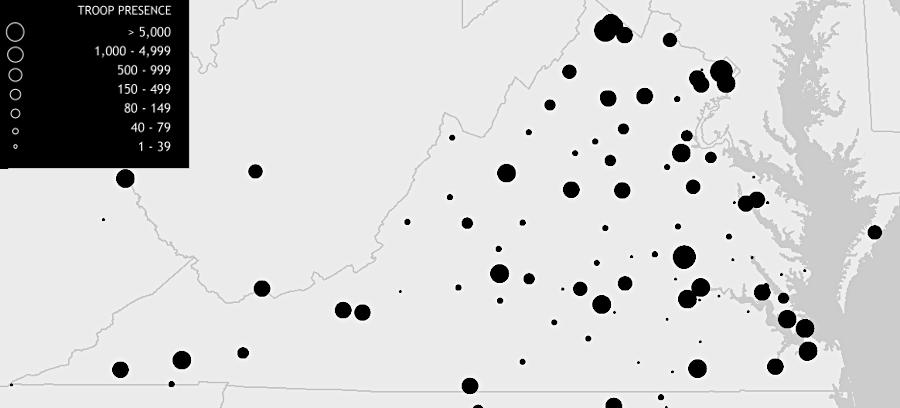
fleeing from slavery (self-emancipation) required planning and courage
Source: HathiTrust, Harper's Weekly, Negroes Escaping Out of Slavery (May 7, 1864, p.292)

fleeing from slavery (self-emancipation) required planning and courage
Source: HathiTrust, Harper's Weekly, Negroes Escaping Out of Slavery (May 7, 1864, p.292)
The largest number of enslaved people to be emancipated in Virginia achieved freedom by their own action. They self-emancipated by fleeing their owners and escaping to a place where they were not returned. Some fled to places where slave hunters could not catch them, such as the maroons who lived in the Great Dismal Swamp. Others fled to the British in the American Revolution and the War of 1812, or the Union Army in the Civil War.
In 1862, Richard Slaughter escaped from the Eppes plantation at City Point. He later described how the US Navy helped him get to safety in Hampton:1
Enslaved people were, on occasion, manumitted by Virginia owners. In some cases, those owners were not whites. Some free blacks and formerly-enslaved people managed to purchase their spouse and/or their children in order to keep the family intact.
Source: Virginia Museum of History and Culture, A Madman's Will: John Randolph, Four Hundred Slaves, and the Mirage of Freedom
Source: Virginia Museum of History and Culture, Escape to the City: Fugitive Slaves in Antebellum Richmond
For example, John Hopes was an enslaved man when he married an enslaved woman in Richmond in 1813. Hopes was emancipated by his owner in 1836, and quickly purchased his son Walter. John Hopes emancipated his own son in 1853.2

John Hopes freed his son Walter in 1853
Source: UnCommonwealth blog, A Case Study Of Freedom: John Hopes
The largest single moment of emancipation came when the Confederate government was defeated in April, 1865. Surrender of the Confederate Army of Northern Virginia at Appomattox ended the open warfare phase of the Civil War in Virginia.
Virginia was occupied by the US Army, which ended up responsible for 800 county governments across the southern states. Army troops were not stationed in every Virginia county, but the legal institution of slavery ended and all enslaved people were emancipated as the news of the Union victory spread across the state. Individuals previously held against their will, and uncompensated for their labor, were entitled to move away - but the logistics and the challenges of starting a new life as an emancipated person of color in 1865 were still daunting.
As one scholar has noted:3

US Army posts during military occupation were scattered at different times across the state
Source: University of Georgia, Harper's Weekly, Mapping Occupation

Robert Carter emancipated Barbara in 1791
Source: Houghton Library, Harvard University, Emancipation document of Barbara, 18 years of Nomony Hall in Westmoreland County, Virginia 1791

enslaved people who escaped to Union lines were declared contrabands, and as "seized property" were retained rather than returned to slaveowners
Source: Library of Congress, Contrabands, Newport News, 1861 (by Alfred R. Waud, 1861)

as in the Revolutionary War, enslaved people joined the invading army in the Civil War to escape to freedom
Source: HathiTrust, Harper's Weekly, Colored Troops, Under General Wild, Liberating Slaves in North Carolina (January 23, 1864, p.52)

the 1864 sketch in Harper's Weekly of Freedman's Village presented an almost-empty community
Source: HathiTrust, Harper's Weekly, Freedman's Village - Arlington, Virginia (May 7, 1864, p.293)
Emancipation from slavery and passage of the 15th Amendment, giving black men the right to vote, did not lead to economic or social equality. White southerners created a system of sharecropping and peonage to maintain a low-cost agricultural workforce. Public school systems and other services were designed and funded to benefit whites, and to discriminate against blacks. Legal restrictions prevented whites and blacks from marrying. Native Americans in Virginia, caught between identity politics that presented all non-whites as "black," struggled to carve out a distinctive third category of "Indian."
In 1885, when the Liberty Bell was brought to New Orleans for a brief visit, the symbolism of a reunited nation obscured the fact that the Southern states had established a system of political, economic, and social discrimination based on race. At times, extra-legal means, including lynchings, were used for enforcement. The business and social elites in Northern states ignored the suppression of the black residents while celebrating the symbolism of reuniting the Union.4

celebrating symbols of reunification ignored the reality of discrimination against people of color
Source: Library of Congress, The liberty bell back in its birth-place again now that it has proclaimed liberty throughout the land unto all the inhabitants thereof, it is perfectly at home (by Thomas Nast, June 27, 1885)

emancipation was celebrated in Richmond with a parade on April 3, 1905 - the 40th anniversary of the Union Army capturing Richmond
Source: Library of Congress, Emancipation Day, Richmond, Va.

Gen. Milroy issued a notice on January 5, 1863 stating that those enslaved were legally freed under the Emancipation Proclamation
Source: National Park Service, Freedom to Slaves!

President Lincoln claimed emancipation was a war measure, reducing the labor and ultimately food/supplies needed by the Confederate Army
Source: New York Public Library, The effects of the proclamation -- freed Negroes coming into our lines at Newbern, North Carolina (1863)

Eastman Johnson painted self-emancipation that he witnessed on March 2, 1862 near Manassas
Source: Brooklyn Museum, A Ride for Liberty - The Fugitive Slaves (by Eastman Johnson, 1862)

George Washington Parke Custis emancipated one of Martha Washington's enslaved children in 1803
Source: Library of Virginia, Louisa: Deed of Manumission (1803)